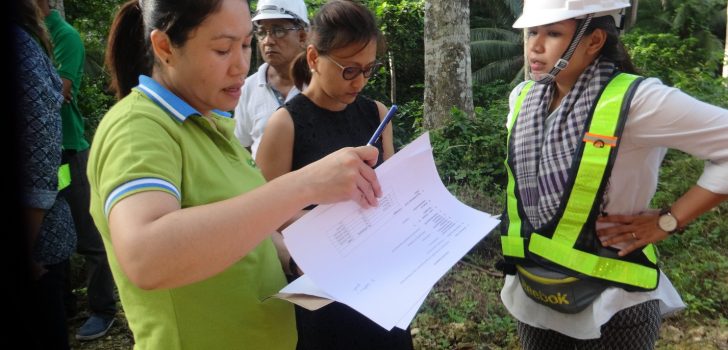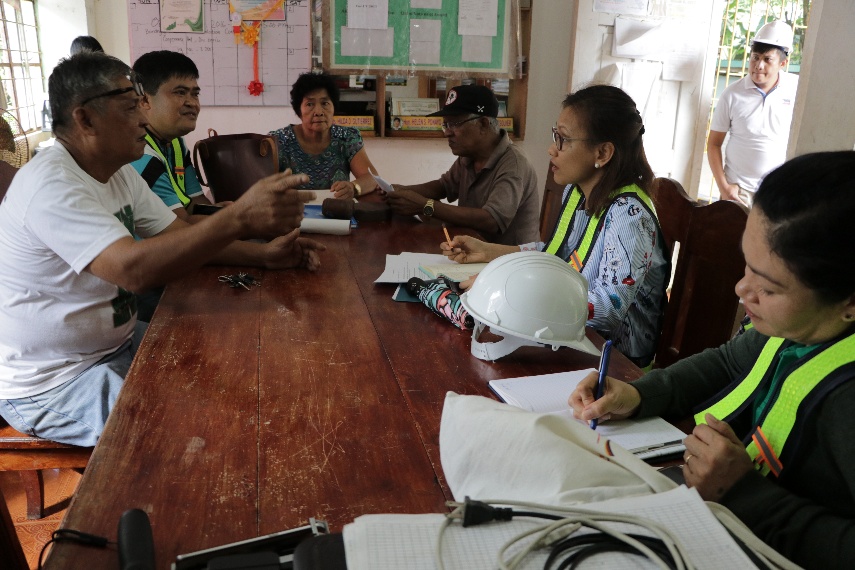 PRDP NPCO SES Unit Head Angelita Martir, World Bank Social Development Specialist Marivi Ladia, and South Luzon PSO SES Unit Head Maria Iris Millendez-Bombay review the SES compliance documents at the Rehabilitation of San Isidro to Pag-oring Nuevo FMR in Libmanan, Camarines Sur. (Photo by Annielyn L. Baleza, DA-PRDP Bicol InfoACE Unit)
PRDP NPCO SES Unit Head Angelita Martir, World Bank Social Development Specialist Marivi Ladia, and South Luzon PSO SES Unit Head Maria Iris Millendez-Bombay review the SES compliance documents at the Rehabilitation of San Isidro to Pag-oring Nuevo FMR in Libmanan, Camarines Sur. (Photo by Annielyn L. Baleza, DA-PRDP Bicol InfoACE Unit) Midterm benefits of PRDP’s Safeguards compliance now felt in rural communities
Resistance on the ground and within the Project makes Social and Environmental Safeguards (SES) a tough job. According to World Bank Social Development Specialist Marivi Ladia, it takes character to implement compliance within the Philippine Rural Development Project (PRDP). However, she noted that because of the SES unit’s commitment, Project beneficiaries now enjoy the benefits of compliance to SES.
During the pre-wrap up meeting of the World Bank Midterm Review Mission held in Naga City on December 7, 2017, Ladia shared that based on dialogues with Project stakeholders, the SES team learned that compliance to SES empowers communities.
“Suddenly, community members are aware that they need to be compensated. Before, they did not know that they were entitled to such,” Ladia said.
Ladia underscored that SES improves the living conditions of the vulnerable sector. “Like when you relocate people and you make sure that they have good relocation sites, it is a catalyst for doing things differently,” she added. She mentioned that it was the first time for many LGUs to compensate affected persons in accordance with the Safeguards Framework. She stated that Project partners at the LGU level now know how to conduct valuation and replacement cost because usually it’s only the zonal value being taken into consideration.
It is the PRDP SES unit’s mandate to identify, prevent, and mitigate harm to communities or people and the environment in subproject areas. Among the unit’s good practices are the implementation of a Resettlement Action Plan, Indigenous People’s Policy Framework, Environmental and Social Management Framework, Road Right-of-Way Acquisition, and the use of Social Inclusiveness Scoring Sheet.
The Land Acquisition and Resettlement Policy Framework, in particular, aims to ensure that all involuntary losses whether land, structures, crops, or other properties of project affected persons (PAPs) receive just and proper compensation. Meanwhile, those who are displaced whether physically or economically are resettled and provided with assistance to improve or at least maintain their pre-subproject living standards and income-earning capacity.
In August 2017, Ladia and the SES teams of the PRDP National Office and the South Luzon Project Support Office (PSO) conducted a separate review mission at the Manangle–Caima Farm-to-Market Road (FMR) in Sipocot, Camarines Sur. On December 4–5, 2017, the team also conducted dialogue with PAPs at the Pistola–Tablon Road in Oas, Albay, the Rehabilitation of San Isidro to Pag-Oring Nuevo FMR in Libmanan, Camarines Sur, and the Pinagwarasan to Lanot FMR in Basud and Merces, Camarines Norte.
During the Midterm Review Exit Meeting, PRDP South Luzon PSO SES Unit Head Maria Iris Millendez-Bombay highlighted the SES unit’s good practices on-site such as the availability of SES documents at the field offices, installation of grievance redress mechanism (GRM) posters, and institutionalization of functioning GRM hotlines.
Moreover, Ladia shared how the PRDP improved the documentation of donations, which means that PAPs will no longer be taxed for portions that they have donated. She also discussed some of the Project’s social benefits to the community particularly in terms of reduction in mortality and morbidity.
Keys to efficient and effective SES implementation
“The SES unit has always enjoyed a consistent satisfactory rating,” Ladia said.
According to Ladia, this can be attributed to the close coordination of SES unit staff. She also mentioned that through the years, the SES team’s capacity greatly improved through trainings that were conducted. Also, the installation of standardized SES procedures and tools guaranteed consistent application of safeguards requirements through all subprojects nationwide. Ladia added that joint technical review and validation activities have also proven to be very effective in ensuring SES compliance.
“Issues are addressed faster. Non-SES staff became aware of SES requirements and have started to care for safeguards. Now you realize you need to work together to ensure the compliance of PRDP subprojects,” she furthered.
Moving forward
To sustain and improve its performance, Ladia recommended to augment the number of SES staff, develop a tracking system/matrix for SES compliance in terms of number of PAPs from planning to implementation and integration of SES works in PRDP processes and trainings. She also cautioned the team in terminating subprojects with SES issues and encouraged them to inform the World Bank and seek assistance in complying with its policies.
The SES unit plans to conduct a Safeguards Thematic Review in 2018 to capture more impacts of the unit to the communities in PRDP project sites. ### (Annielyn L. Baleza, DA-PRDP Bicol RPCO InfoACE Unit)

PRDP NPCO SES Unit Head Angelita Martir, World Bank Social Development Specialist Marivi Ladia, and South Luzon PSO SES Unit Head Maria Iris Millendez-Bombay review the SES compliance documents at the Rehabilitation of San Isidro to Pag-oring Nuevo FMR in Libmanan, Camarines Sur. (Photo by Annielyn L. Baleza, DA-PRDP Bicol InfoACE Unit)

